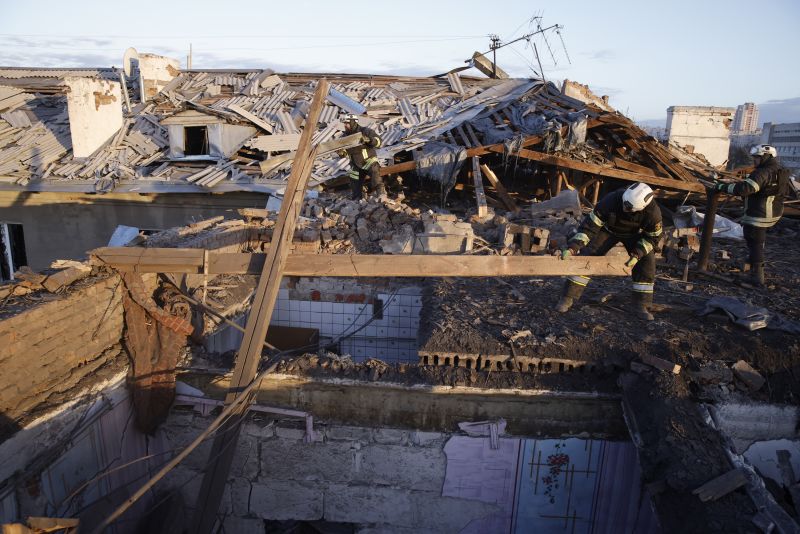It generated little attention: another Russian assault in eastern Ukraine, across barren, pock-marked fields, met by determined, nimble resistance.
In an attack that defied logic, a Russian armored column lumbered across open countryside near the village of Tonenke in Donetsk and was picked off by drones and anti-tank weapons. Geolocated videos indicate that the Russians lost about a dozen tanks as well as other armored vehicles.
Once more, Ukrainian units repelled a poorly-planned assault and held their positions. But these frequent mechanized ground attacks by the Russians are like sand-blasting – eroding Ukrainian defenses in multiple spots along the frontlines.
Kateryna Stepanenko at the Institute for the Study of War in Washington says Russia’s likely goal is to test Ukrainian defenses for weak spots and strain Ukrainian defensive capabilities ahead of reported upcoming summer offensive operations.
Ukraine’s frontline brigades are clinging on – awaiting munitions and air defenses from allies, fresh recruits from a new mobilization law that expanded the eligible age range, and hoping Russian commanders will continue to make mistakes.
They are using scarce artillery shells (the ratio is at least 5:1 against), and thousands of small drones that pick off individual vehicles.
The Ukrainians assert that morale is poor in enemy ranks. “They are ready to pay bribes, which is happening on a massive scale, injure themselves or simply run away to avoid the frontline, as the chances of survival there and the number of losses…remain sky-high for Russians,” according to Andriy Yusov, Ukrainian Defense Intelligence representative.
But according to the UK’s Defense Ministry, Russia is able to replenish its front-line forces by 30,000 troops a month. Its military industries are working 24/7 to churn out everything from tanks to drones to guided bombs.
US Deputy Secretary of State Kurt Campbell said this week that despite immense losses, Russia had “almost completely reconstituted militarily” – possibly allowing it to intensify ongoing offensive operations.
Matthew Schmidt, Associate Professor in the National Security Department at New Haven University says that “Russia is pushing ill-manned, ill-equipped local offensives anywhere it can. But ill-manned with enough bodies might be good enough.”
By contrast, Ukraine’s manpower shortage is chronic. The call-up age has been lowered from 27 to 25 but other parts of a mobilization bill are still struggling to pass through the Ukrainian parliament. The new commander-in-chief, Gen. Oleksandr Syrsky, has suggested that an original target of 500,000 more recruits can be “significantly reduced”; others are skeptical.
In Stepanenko’s view, Ukraine “will likely need to cede some tactical territory and retreat to more defensible positions in some battlefield scenarios… Russia’s ability to retain the initiative on the battlefield is forcing Ukrainian troops to expend already scarce materiel.”
Overwhelming force – 1.5-tonne guided bombs from the air, intense artillery barrages, heavy flame-throwers and tank-fire – takes its daily toll.
“They are dropping heavy ammunition on us without even flying near the contact line or entering our air defense zone,” he said.
Exactly the same tactic applies to the Avdiivka area, Volosyn says. “When their aircraft are working, it is impossible for our defenders to work, they only need to hide in cover.”
Ukrainian officials speak of fatigue and frustration but take heart from the ineptitude of some Russian commanders. After Tonenke battle last week, one soldier described amazement at the sheer number of Russian soldiers dying “in bundles due to the ambitions of one small man,” reflected one soldier, referring to Russia’s President Putin.
And yet the Russians are not doomed to repeat their mistakes. They have shown an ability to adapt, especially in building multi-layered defenses that scotched the Ukrainian offensive last summer, in deploying glide bombs beyond the range of Ukrainian defenses and in developing their own array of attack drones.
Most recently, according to Ukrainian officials, they have begun equipping cruise missiles with cluster munitions.
Ukraine has responded with a rapid expansion of its own arms industry, in many ways more innovative than the Russians’, especially in developing long-range drones at sea and in the air.
Ukraine is waging a ‘near war’ of close-quarter battles and a “far war” aimed at Russian infrastructure and logistics: oil refineries, airfields and factories.
In the last week alone, its home-made drones hit a plant making UAVs 1,300 kilometers inside Russia. Another wave of drones crippled a dozen Russian planes at an airfield in Rostov.
Ukraine’s Third War
There is also a third war that goes on in hushed corridors either side of the Atlantic: how to sustain the Ukrainians in a more consistent way.
This week NATO Secretary-General Jens Stoltenberg said it was time “to discuss a long-term financial pledge commitment from NATO allies.”
That may include a long-term funding arrangement under NATO’s auspices that would mitigate any decisions by a potential Trump administration next year to end support for Ukraine.
Ukrainian officials never tire of telling their backers what’s needed now: Patriot and other air defenses, longer-range missiles, artillery shells by the million, more air power.
Attending a NATO gathering this week, Ukrainian Foreign Minister Dmytro Kuleba said that it’s “impossible to understand why the allies cannot find additional batteries to deliver them to a place where ballistic missiles are fired daily. In March alone, 94 ballistic missiles were fired at Ukraine.”
Kuleba has been saying this every week for many months. The US and 17 other nations, among them several NATO members, have dozens of Patriot systems. Ukraine has received less than a handful.
Paralysis in the US Congress means that Ukraine’s broader military needs are going unanswered. A bill that would release $61 billion in military aid has not advanced in four months.
And time is running out. An official in Ukraine’s National Security and Defense Council, Lieutenant Andriі Kovalenko, said that Ukraine’s allies “must understand that if Western aid does not arrive on time, the enemy will have more chances to capture more territory here or there.”
At least some perceive the urgency. Czech President Petr Pavel has put together a ‘shell coalition’ that is trying to fund the purchase of nearly a million shells held in non-Western countries. The European Union has promised to expedite the shipment of shells after failing by some distance to meet its pledge in the past year.
Europe is not ready or able to assume the leadership role currently occupied by the US in providing the volume of weapons needed nor the real-time intelligence shared with Ukraine.
Kyiv faces the same problem it has since the onset of the Russian invasion: for all the ingenuity and courage its troops show in the face of Russia’s brute force, the reticence of its backers mean they frequently have one hand tied behind their back.
Nor is Ukraine equipped to take advantage of those mistakes. Stepanenko at the Institute for the Study of War says Ukraine can’t exploit the high levels of attrition that Russian units suffer.
Ukraine has no choice but “to dig in and try to anticipate to the best of its ability where, when, and at what intensity Russian forces will attack next,” Stepanenko said.






